19 Best Dog Friendly Golden Larch Hikes in Washington State
Viewing the golden larch trees in fall is a favorite Washington State pastime.
The race, or competition, to catch them at exactly the right time, and see as many as you can, has even been dubbed “Larch Madness” by locals.
Unfortunately, not all of the hikes that have larch trees are dog friendly.
Don’t let that deter you though! There are still plenty of larch hikes in Washington that are accessible to you and your dog.
I almost exclusively hike where I can bring my dog. If they can’t go, neither do I.
I put together this list of great dog friendly fall larch hikes to help others like me that don’t hike trails their dog isn’t allowed on.
The bonus is that many of them are just a day trip from Seattle.
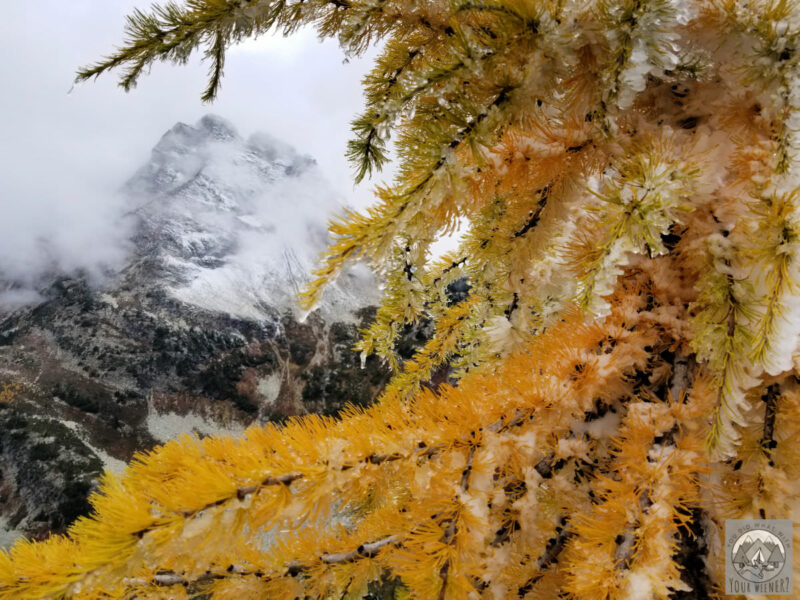
What is a Larch Tree and Why Are They Spectacular in Fall?
Larch trees are deciduous conifers with clumps of needles that turn bright yellow in fall and drop off in the winter.
They are part of the genus Larix and pine family Pinaceae and grow to a height between 65 and 160 feet tall.
Larch trees can be difficult to spot in spring in summer because their needles are green so they blend in with other evergreen trees growing in the mountains.
However, in spring, their needles are sometimes lighter and brighter green than most of the evergreen trees around them.
If you look close, you will see tufts, or clusters, of short needles and will find only a single cone per shoot of needle clusters.
As the summer progresses, the light green needles darken and eventually start to turn yellow as the Larch tree prepares to shed its needles to conserve energy during winter.
By early to mid fall, most larch trees are a gorgeous golden, flaming yellow.
Why Viewing Golden Larch Trees In Washington Feels Special
There are a few things that make fall larch spotting a magical experience.
Golden larches are striking against the evergreen backdrop
A large portion of the indigenous tree species in Washington State are evergreens, meaning that they stay green all winter and won’t lose their needles.
This provides a striking contrast to the golden larch and provides a great background.
Larch trees don’t grow everywhere in Washington State
Another part of what makes viewing golden Larch trees in fall is that they only grow in certain areas of Washington State so seeing them feels kind of like a treasure hunt.
And most grow on high mountain slopes so you likely have to work for the viewing pleasure.
The window for prime viewing of golden larches is short
Larch trees are only in their prime golden state for a few weeks each year.
Before that prime larch viewing window, the needles aren’t fully yellow yet.
After this window, they start to drop their golden needles and look ragged.
To add to the urgency, the dates of this prime larch viewing window varies from year to year, depending primarily on moisture levels and weather.
The Larch vs Tamarack Debate. Who is Right?
Generally, people who grew up in the Pacific Northwest call these golden coniferous trees larch trees.
But many people who live here call them Tamarack trees.
Who is right?
Both Larch and Tamarack trees are members of the Larix species.
However, the larch trees in Washington State are either Larix Occidentalis (Western Larch) or Larix Lyallii (Subalpine Larch).
Tamarack is the common name for Larix Laricina – the Eastern Larch.
As the name implies, these trees only grow in the eastern parts of the contiguous United States (and parts of Canada).
Specifically, tamarack trees grow in the upper Northeast United States from Minnesota to West Virginia and Canada from the eastern Yukon to Newfoundland.
So if someone in Washington State calls the golden yellow, deciduous needle-bearing trees in Washington State tamarack, you can be pretty sure they are from somewhere further east or learned the name from someone who was.
This article about why the two different species are both sometimes referred to as tamarack explains:
“Whether you call Montana’s fall fireworks Larch or Tamarack may come down to a question of your roots.
“The older families here,” says Flathead Valley Community College instructor Bob Beall, “they came from Minnesota and Wisconsin, they brought the name [Tamarack] with them.”
On the other hand, Beall says many of the families in Libby came from the Olympic Peninsula. They call it Larch.”
Another article from Montana, where the larch vs tamarack debate clearly exists too, says:
“Technically, out here in Northwest Montana, they’re probably going to be Western larch, according to Montana Fish, Wildlife and Parks.
True tamarack trees — Larix laricina — are not native to Montana or the Northwest U.S. Western larch — Larix occidentalis — grow here, whereas Tamaracks are the eastern varietal.“
But, I admit there is some conflicting information out there. Although this is one of the very few sources I found that associates western larch and “tamarack”, a few do exist.
Some articles, like this one, even do associate western larch and the name “tamarack” but attempts to clarify which name should be used when:
“Western larch is also called mountain larch, hackmatac, tamarack, or western tamarack. The Native American name hackmatac is seldom used, and tamarack should be reserved for Larix larcina of the northeastern United States and Canada.”
So, to end the debate for once and for all, the technically correct name for these trees in Washington State is Larch.
However, if someone chooses to call the trees tamarack, just let them and know they are referring to the same tree that is called “larch”.
The two are in the same genus, or family, of tree species.
Although they are scientifically different, and they appear slightly different, it’s largely semantics to non-tree geeks.
When Can I See Golden Larches in Washington?
Fall is prime viewing time for viewing golden larch trees in Washington State.
The fall season officially starts on September 22nd and ends on December 21st but the golden larches are typically in their prime between the end of September and mid October.
Although the general larch viewing window is from the end of September to the end of December, in my experience, the subalpine larch (Larix Lyallii) turns yellow before the western larch (Larix Occidentalis).
That means that the prime viewing time for subalpine larch trees is earlier than the prime for western larch trees.
If you choose to participate in “larch madness” by following the golden colors around the state, you could potentially see larch trees at their best for a 4-6 week period.
By the end of October, larch trees have shed a significant amount of needles onto the ground but I’ve found single golden larch trees, or small stands, that are photo-worthy as late as Mid November after it has started to snow.
While not necessarily at their best, it’s a beautiful sight to see a golden larch peeking out from a thin blanket of snow!
If you want to time things right, the best way to determine the status of larch trees turning golden yellow in a specific area is to read the Washington Trails Association trip reports for the trail.
Locals are really good about leaving information there for the next hikers, including how close the larches are to their peak.
To filter the trip report results, you can enter the name of a specific hike into the search field or or you can go to “advanced options” and enter larch into the search line.
Also, even though it’s only a prediction map, the Smokey Mountains Fall Foliage map does cover the entire contiguous US and looks to be updated regularly (this one is new to me so I can’t attest to the accuracy).
Note: Wildfires are becoming common all around the US and especially in the Northwest. Unfortunately, fire season can still be in full roar during larch seasoon. Consider checking out the Gaia smoke forecast layers (free to use) before you go for the best views.
What is the Best Weather and Time of Day to View Golden Larch Trees?
Some of the most striking larch photos are taken on a sunny, clear day when the larches can be viewed against a bright blue sky.
So keep an eye on the weather forecast!
Early morning and about an hour before sunset (known as golden hour by photography buffs) provide a soft light that can make larches look even more incredible.
Do note that most larch hikes are at least 3 miles long so you’ll need to give yourself enough time to hike back to the car before it gets dark or bring a headlamp so you can hike out in it (suggested only for experienced hikers).
Where Can I Find Larch Trees in Washington State?
Wondering where you can see larch trees in Washington?
I list a number of hikes below but there are also trails that have not made my list (at least not yet) and roads you can drive to see golden larches.
In general, this is where you will find the two different types.
Western Larch
The Western Larch grows on north-facing slopes at an elevation of 2,000-5,500 feet and can be found from just east of the Cascade crest (although it can sometimes be found a bit west of the Cascade crest) to the Idaho border.
The greatest concentrations are found in the northeast sections of Washington and along the east slopes of the Cascade Mountains.
The western larch can reach up to 170 feet tall and have a triangular shape (longer branches down low and narrow crown).
A really great area for fall western larch viewing by car and by foot is along Blewett Pass highway between Cashmere, WA and Cle Elum, WA.
Subalpine Larch
The subalpine larch tree is a lot smaller than its cousin, the western larch, and reaches around 70 feet tall.
It’s found in high mountain regions from 5,800-7,500 feet from Wenatchee, WA north to Canada and east to northern Idaho and western Montana.
It’s typically found in places that become cold and snowy in winter and/or on bedrock or talus outcropping
One of my favorite places to view subalpine larch trees is near the summit of Washington pass along Highway 20.
What is the Weather Like When Viewing Golden Larches in the Fall?
Golden larches can be viewed in the early to late fall.
Weather during this time of year can be unpredictable in Washington.
While you may sometimes get sunshine during the day that makes it feel hot, the mornings will be chilly at best and it will get cold fast after the sun goes down.
The weather can also be clear and near freezing or cold, damp and foggy.
Or it can feel like winter and snow on you.
Fall weather in the mountains can change rapidly so sometimes you can experience all those weather conditions on the same day!
Add to that, larches grow at an elevation of around 3,000 feet or higher so you can expect temperatures on your hike to be significantly colder than in the nearest lower-elevation town, which you probably used as a location to check the weather.
The general rule is that temperature decreases by about 5 °F for every 1,000 feet of elevation gain.
So, for example, let’s say you checked the daily temperature forecast for Leavenworth, WA, which sits at 1,171 feet above sea level, and it was supposed to be 60 °F.
That’s a pretty pleasant fall day, right?
But the hike you are doing will take you up to an elevation 5,000 feet – a difference of almost 4,000 feet.
You should expect the temperature on your hike could reach a low of 40 °F ((60 – (4 x 5)), which is significantly colder!
So the bottom line is that you need to be prepared for colder and wetter hiking conditions than in the summer and you need to be prepared for the weather to change rapidly and without warning.
By early to mid November, depending on the year, you could encounter snow on your hike.
What Should I Pack for a Fall Larch Hike with My Dog?
Given that the weather for fall hikes is often colder and more unpredictable than it is for summer hikes, you will have to prepare differently for you and your dog.
Be prepared for rapidly changing weather conditions, cold, ice, and snow.
Besides what I pack when hiking with my dogs in summer, I bring some extra items for fall:
- A warmer jacket for my dogs
- Extra clothing layers for me – usually a long sleeved shirt or light jacket
- Hat and gloves for me
- Headlamp in case we get caught in the dark
- Microspikes
- Gaiters
- Pole(s)
- Emergency survival kit (in case I have to spend a night in the cold)
Best Hikes to See Larches in Washington With Your Dog
I’ve been hiking in Washington State with my dogs for over 20 years.
I put together this list of what I think are some of the best dog friendly Larch Hikes in Washington.
Most Popular Larch Hikes in Washington
The most popular fall larch hikes are often the easiest to get to – they may be the closest to Seattle and trailheads are often right off the highway – and they have some of the highest density of golden larches for miles, and have some of the best views.
Popularity comes with a cost though.
It’s not uncommon for over 1,000 hikers to visit them on weekends (which is now at least Friday, Saturday, and Sunday) when larch trees are near at their peak of gold spendor.
Parking lots are full and vehicles line the shoulders of nearby roads and highways, often adding 1-2 miles to the overall distance of the hike.
Because these hikes are dog friendly, and not all of the “famous” fall larch hikes in Washington are, dog owners are often left with no choice but to hike these trails.
Still, they are spectacular and worth visiting at least once.
I’ve braved the crowds and been “part of the problem” on several occasions.
I still think it can be worth it as long as you go with the right mindset and expectations.
The most popular, and crowded, dog friendly fall larch hikes in Washington are:
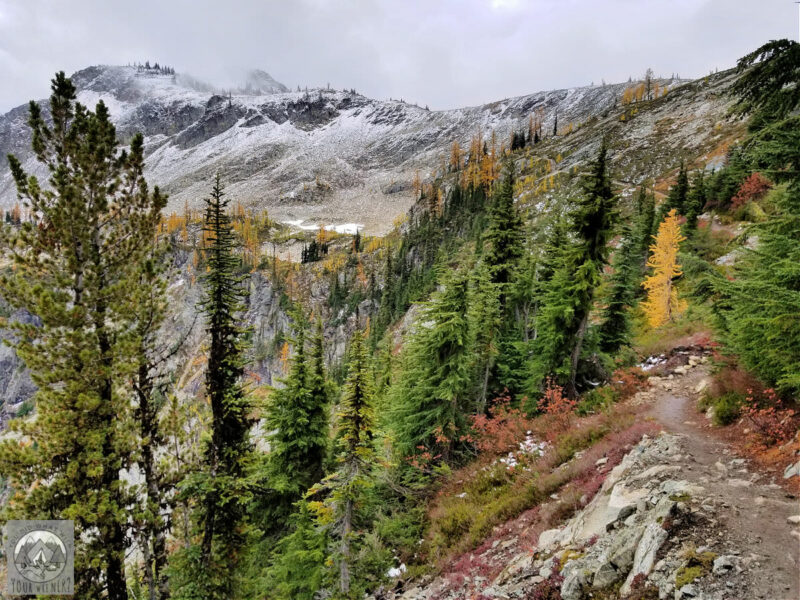
1) Heather-Maple Pass Loop
The Heather-Maple Pass loop was the first hike I ever went on to view subalpine larches and it’s held a special place in my heart ever since then.
This loop hike pairs an abundance of golden larches in fall with dramatic views of North Cascades peaks.
The trail skirts the boundary of North Cascades National Park (which is why dogs are allowed here) and, to me, offers one of the best views of the park’s interior mountains.
The loop can be done clockwise if you want to get the forest portion done first or counter-clockwise if you want a more gradual climb to the pass. Most people choose to hike it counter-clockwise.
Although it makes the total mileage longer, my favorite part of the trail is the climb up to the high point above Lake Ann (when going counter-clockwise).
I prefer to go back down the same way I came vs heading down through the woods where there are less views.
Location: Highway 20 Rainy Pass; 3 hours 30 minutes from Seattle
Total Mileage: 7.2 miles roundtrip
Elevation gain: 2,000 feet
For more information visit:
Washington Trails Association (WTA)
AllTrails
2) Cutthroat Lake
Cutthroat Lake is one of the easiest larch hikes on this list so it’s ideal for senior dogs and small children.
Hike into this grassy, forested lake set in the rocky basin beneath Cutthroat Peak for spectacular views of golden rocks matching the golden larches of fall.
There is no established trail around the lake, but it is possible to spread out along the grassy lakeshore.
If you want to make this hike longer and more challenging, you can continue up to the PCT and Cutthroat Pass.
Location: Highway 20 Mazama/Winthrop; 3 hours 45 minutes from Seattle
Total Mileage: 3.8 miles roundtrip
Elevation gain: 479 feet
For more information visit:
Washington Trails Association (WTA)
AllTrails
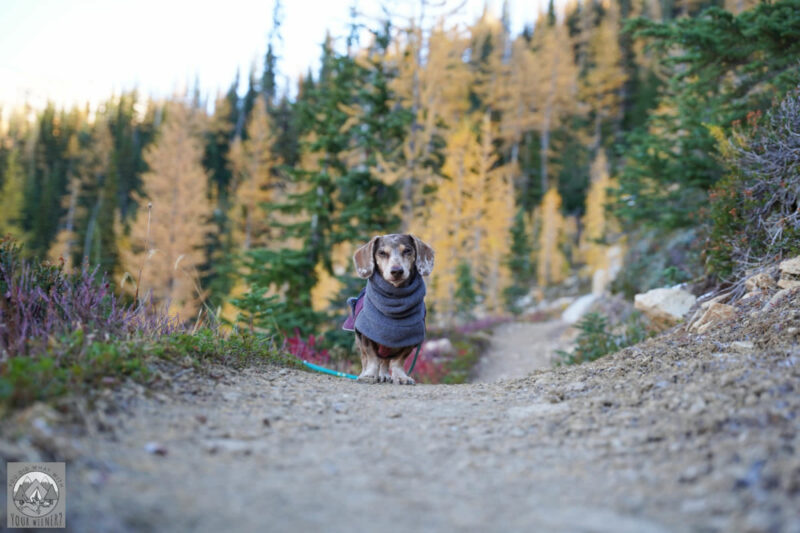
3) Cutthroat Pass via the Pacific Crest Trail
Cutthroat Pass is listed as a challenging hike with creek crossings and steep switchbacks offering spectacular views shared with Pacific Crest Trail (PCT) hikers.
I hiked this for the first time in 2021 and didn’t feel like it was that hard. Maybe I was just in good shape and/or the spectacular view at the pass made me forget the work I had to do to get there.
You’ll cross a handful of small creeks during the first half mile but they can run high in fall so hiking poles can be helpful for crossing.
After you pass the biggest creek – Porcupine Creek at 1.5 miles – you’ll start the ascent towards the pass.
Once you reach the top, stop and enjoy a packed lunch with views of the surrounding peaks and Cutthroat Lake in the valley below.
Location: Highway 20 Rainy Pass; 3 hours 30 minutes from Seattle
Total mileage: 10 miles roundtrip.
Elevation gain: 2,000 feet.
For more information visit:
Washington Trails Association (WTA)
AllTrails
4) Cutthroat Pass via Cutthroat Lake
You can also combine the previous two hikes by first making the relatively easy trek to Cutthroat Lake and then heading up some steep switchbacks to meet up with the PCT and Cutthroat Pass.
If you want to bypass the lake, take the right-hand trail (but honestly, in my opinion, if you are going to bypass the lake you might as well hike to Cutthroat Pass from the PCT trailhead).
Location: Highway 20 Rainy Pass; 3 hours 30 minutes from Seattle
Total mileage: 11.4 miles roundtrip
Elevation gain: 2,300 feet.
For more information visit:
Washington Trails Association (WTA)
AllTrails
5) Blue Lake
A short hike suitable for everyone makes this a must-do hike along Highway 20 for gorgeous views of granite peaks and a beautiful mountain lake.
With the trailhead parking lot right off the highway, you will waste no time getting onto the trail.
Blue lake is a pretty alpine lake set up against towering granite peaks and meadows. And of course golden larch trees in fall.
If you have the time, stop at the Washington Pass Lookout for amazing views of the Liberty Mountain group.
Location: Highway 20 North Cascades. 3 hours 30 minutes from Seattle
Total mileage: 4.4 miles roundtrip
Elevation gain: 1,050 feet
For more information visit:
Washington Trails Association (WTA)
AllTrails
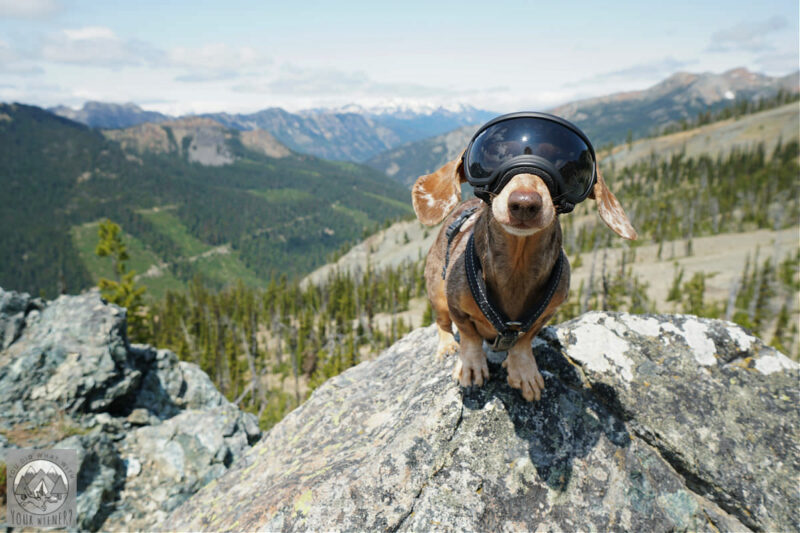
6) Esmeralda Basin (Esmerelda)
The trail begins at the end of the North Fork Teanaway Road.
Follow the trail as it meanders along an old mining road and pass the junction with the Ingalls Way and Longs Pass Trail.
The wide, old roadway eventually narrows as the trail climbs higher along the hillside and, eventually, the trail skirts the slopes of Ingalls Peak as it heads northwest.
You can view several jagged peaks from the top of the pass and, and if you scramble the rocky hill to the south of the pass, Mount Rainier can be seen in the distance beyond Gallagher Head Lake.
Several golden larch trees dot this trail and can be seen on the hillsides to the north.
Location: Highway 970 Teanaway. 2 hours 30 minutes from Seattle
Total mileage: 7.5 miles roundtrip
Elevation gain: 1,750 feet
For more information visit:
Washington Trails Association (WTA)
AllTrails
Less Crowded Larch Hikes in Washington
It is possible to find dog friendly fall larch hikes in Washington that are less crowded.
Some of these aren’t any less beautiful than the popular ones everyone flocks to listed above.
While some do have less golden larches per mile, what the trails lack in abundance, they make up for in solitude.
Still, these hikes are often less crowded for good reason.
They may be more difficult to get to – both in distance from Seattle and the road conditions may make getting there more challenging (ie. a high clearance vehicle may be a necessity) – or the terrain may be more challenging.
However, if you are willing to venture a little further, and navigate a dirt road with a lot of potholes, you and your dog may be rewarded by being able to enjoy the views in peace and relative solitude.
Because of that, these trails are good choices if you have a reactive dog or one that is not comfortable with strange people and dogs.
7) Tronsen Ridge
Tronsen Ridge is a long but relatively flat trail with the most common access to this hike being via the Five Mile Road on top of Blewett Pass.
If you don’t have a high clearance vehicle, some confidence driving off road, and an aversion to “pin stripes” on the side of your vehicle, you can drive to the trailhead.
Otherwise, it’s best to park near the highway and walk the extra miles to the trailhead. The views from the road are great.
An alternate access point is to take Forest Service Road 9716 from Blewett Pass onto Forest Road 9712 and then park at the Ken Wilcox Horse camp.
To get to the Tronsen Ridge Trail from there, you hike up the road and then turn left/north first on the Upper Naneum Trail to connect with the Tronsen Ridge Trail.
Location: Highway 97 Blewett Pass; 2 hours 30 minutes from Seattle
Mileage: 8 miles roundtrip
Elevation gain: 1,000 feet
For more information visit:
Washington Trails Association (WTA)
AllTrails
8) Clara and Marion Lakes
Clara and Marion Lakes is a short, forested hike into two small alpine lakes surrounded by golden larches in the fall.
The formal trail ends at Marion Lake, but the surrounding hills and slopes of talus have potential for more adventures to be had, or you can just find a good spot to relax in the shade or skip some rocks on the lake with your pup.
Location: Highway 285 Wenatchee; 3 hours 30 minutes from Seattle and 1 hour from Leavenworth
Mileage: 3.2 miles roundtrip
Elevation gain: 900 feet
For more information visit:
Washington Trails Association (WTA)
AllTrails
9) Lake Ann (Teanaway) via Esmeralda Basin Trail
This rugged and steep trail shares a parking lot with the Esmeralda Basin hike listed above.
You start at the same trailhead and pass the first junction to Lake Ingalls (where dogs are NOT allowed) and head north at the trail junction just below the high point of the Esmeralda trail hike (the pass).
Because this trail shares a parking lot and part of the trail with several popular hikes,the parking lot and first part of the trail can be crowded.
However, once you branch off the main trail to Lake Ann, you will likely encounter less people.
Location: Highway 970; Snoqualmie Region. 2.5 hours from Seattle
Mileage: 8.2 miles roundtrip
Elevation gain: 2,200 feet
For more information visit:
Washington Trails Association (WTA)
AllTrails
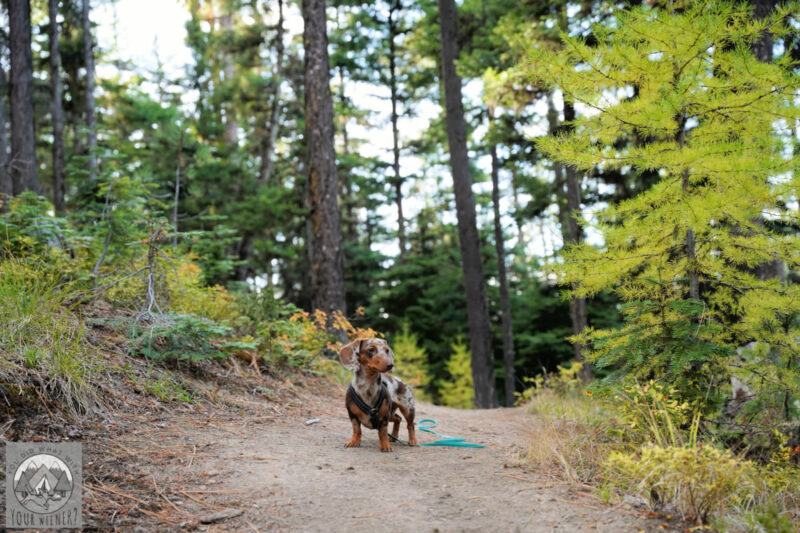
10) Swauk Discovery Trail
If you want to see larches, this is where you’ll see them both next to the discovery trail and in the distance dotting the surrounding mountains.
Most hikers enjoy this trail counter-clockwise.
The parking lot becomes a sno park after the snow gets deep enough for cross country skiers and snowmobilers (usually Nov 1st), so the road may be closed but you can park among the winter users in the big parking lot and hike approximately a half mile to the trailhead from there.
Location: Highway 97 Blewett Pass; 2 hours from Seattle
Mileage: 2.45 miles round trip
Elevation gain: 660 feet
For more information visit:
Washington Trails Association (WTA)
AllTrails
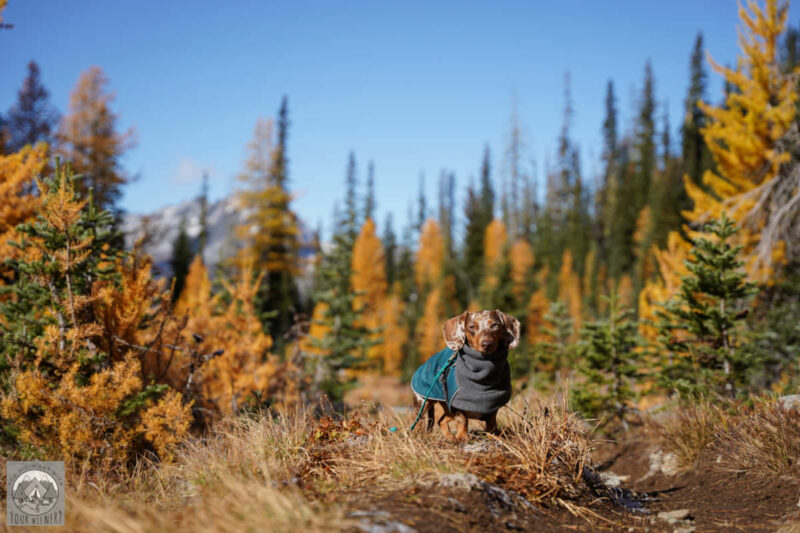
11) Carne Mountain
Carne Mountain Trail is an out and back, lightly trafficked trail located near Lake Wenatchee in the Glacier Peak Wilderness.
It’s definitely a difficult climb but worth it.
I hiked this trail for the first time in 2021 and was blown away by the density of larch trees in the meadow just before the final ascent and the larch and mountain views at the top.
This hike is definitely one of my top fall favorites.
Location: Highway 2 Lake Wenatchee area; 3 hours 30 minutes from Seattle
Mileage: 7.7 miles roundtrip
Elevation gain: 3,579 feet
For more information visit:
Washington Trails Association (WTA)
AllTrails
12) Sherman Peak Loop
This six mile loop offers a nice day hike option in the highlands of Eastern Washington with stunning views of larch trees in the fall.
Due to its proximity to the road, traffic on the road can be heard for much of this hike, but the over 400 types of plants found here make up for that.
Location: Highway 20 near Republic; 6 hours from Seattle (so best to make it an overnighter)
Mileage: 5.9 miles roundtrip
Elevation gain: 1,800 feet
For more information visit:
Washington Trails Association (WTA)
AllTrails
13) Libby Lake
The hike into Libby Lake is a strenuous hike in the Sawtooth Range that ends at an alpine lake tucked into a talus bowl with a larch-fringed outlet.
While there are lengthy level sections along this trail, you have to make up the elevation gain with climbing sections that are steeper than one would expect.
But as you climb, you’ll encounter different climate zones, various forest types, and patches of forest heavily impacted by the 2018 Crescent Mountain Fire.
Location: State Route 153 Twisp/Winthrop; 4.5 hours from Seattle
Mileage:10.2 miles roundtrip
Elevation gain: 3,210 feet
For more information visit:
Washington Trails Association (WTA)
Forest Service
14) Crater Lakes
There’s a reason why this area is sometimes called the Golden Lakes, with larches clinging to the steep and rocky slopes above.
While this hike is gorgeous in the summer, in the fall the air is cool, the bugs are gone, and the larches are gold.
There are several hike-in campgrounds on the trail, and some good fishing spots in the lakes, so you can turn this into a backpacking trip for you and your pup by planning to camp and visit several lakes in the area (like the one below).
Location: State Route 153; North Cascades – Methow/Sawtooth 4 hours from Seattle
Mileage: 8.6 miles roundtrip
Elevation Gain: 2,220 feet
For more information:
Washington Trails Association (WTA)
AllTrails
15) Eagle Lakes
Eagle Lakes begins at the same trailhead as the Crater Lakes hike above and is part of the popular Sawtooth Lakes Loop (aka Golden Lakes Loop).
The Eagle Lakes Trail (431) is mostly forested, starting with mature pine which turns to subalpine fir & larch, finishing above treeline at Horsehead Pass.
Keep in mind, Eagle Lakes trail is a popular multi-user trail, so expect to meet horses, bicycles, and motorcycles on the weekends
Location: State Route 153 Methow/Sawtooth; 4 hours 30 minutes from Seattle
Mileage: 12.5 miles roundtrip
Elevation gain: 2,350 feet
For more information visit:
Washington Trails Association (WTA)
AllTrails
16) Scatter Lake
Scatter Lake is one of the best day hikes for larch-spotting in the fall!
A difficult trail of switchbacks with a rewarding endpoint of Scatter Lake, where you can enjoy a short trail around the lake soaking in the views (and your feet!)
Location: Highway 20 – Twisp/Methow/Sawtooth; 5 hours from Seattle
Mileage: 9.2 miles roundtrip
Elevation gain: 3,850 feet
For more information visit:
Washington Trails Association (WTA)
AllTrails
Dog Friendly Backpacking Trails with Golden Larch Trees
17) Cooney Lake
The Cooney Lake hike leads to a beautiful lake basin filled with larch trees and expansive views of the peaks above.
It’s a 14-17 miles round trip hike no matter which way you get there, which makes it suitable for a super long day or an overnight trip.
You can take the Golden Lake Loop clockwise out to the lake and back for a little over 17 miles round trip and 2,537 feet of elevation gain.
Or you can retrace this person’s route from Foggy Dew Trailhead to Cooney Lake and back for about 16 miles round trip and 3,806 feet of elevation gain.
Location: State Route 153 Methow/Sawtooth; 4 hours 30 minutes from Seattle
Mileage: 17.6 miles roundtrip
Elevation gain: 2,850 feet
For more information visit:
Washington Trail Association (WTA)
AllTrails
18) Golden Lakes Loop
The Golden Lakes Loop, also called Angel’s Staircase if you do the same route without the side trip up to Upper Eagle Lake, is a popular and challenging 23.1 mile loop in the Lake Chelan-Sawtooth Wilderness.
It’s a long and challenging route but you are rewarded fantastically with views of jagged mountains, alpine basins filled with flowers, and a lot of golden larch trees in fall.
Location: State Route 153 Methow/Sawtooth; 4 hours 15 minutes from Seattle
Mileage: 24 mile loop
Elevation gain: 5,223 feet
For more information visit:
AllTrails*
Mountaineers
*do note that this listing says the trail is not dog friendly. However, AllTrails says that dogs are allowed on the Angels Staircase loop and the Eagle Lake Trail, which comprises the total of this route. I also know it is a multi-use trail (Angel’s staircase is one of the most epic mountain bike trails in the Winthrop area) and trails that allow bikes and motorcycles also allow dogs.
19) Cutthroat Pass via the Pacific Crest Trail
You can hike to Cutthroat Pass along the PCT and back in a day (as mentioned above), but it’s also a popular overnight backpacking trail which allows more time to soak in those views!
And you can explore even further north on the PCT if you plan to stay the night.
On the way up from Highway 20, you’ll cross a handful of small creeks during the first half mile but they can run high in fall so hiking poles can be helpful for crossing.
You’ll want to fill up on water at one of these creeks as you are unlikely to find water up higher.
After you pass the biggest creek – Porcupine Creek at 1.5 miles – you’ll start the ascent towards the pass.
Once you reach the pass, stop and enjoy a packed lunch with views of the surrounding peaks and Cutthroat Lake in the valley below. There are a few suitable surfaces to camp at the pass or you can hike further to find a campsite.
Location: Highway 20; 3 hours 30 minutes from Seattle
Total mileage: 10 miles roundtrip.
Elevation gain: 2,000 feet.
For more information visit:
Washington Trails Association (WTA)
AllTrails
Can I See Larches In Seattle?
If you want to enjoy golden larch trees in fall but don’t have the time or desire to drive hours outside of the city and huff and puff up a mountainside, that’s ok!
While there are several parks in and around Seattle that have planted larch trees, only a few are dog friendly.
According to Curbed Seattle, “You can find larches at Washington Park Arboretum, Ravenna Park, and Woodland Park.”
Dogs are allowed at all 3 of these places.


About the Author
Hi, I’m Jessica. I’ve been studying the Dachshund breed since 2007, owned 3 of my own, and shared in the lives of thousands of others through their owner’s stories. When I’m not sharing what I know on this blog, you can find me hiking, camping, and traveling with my adventurous wiener dogs.
